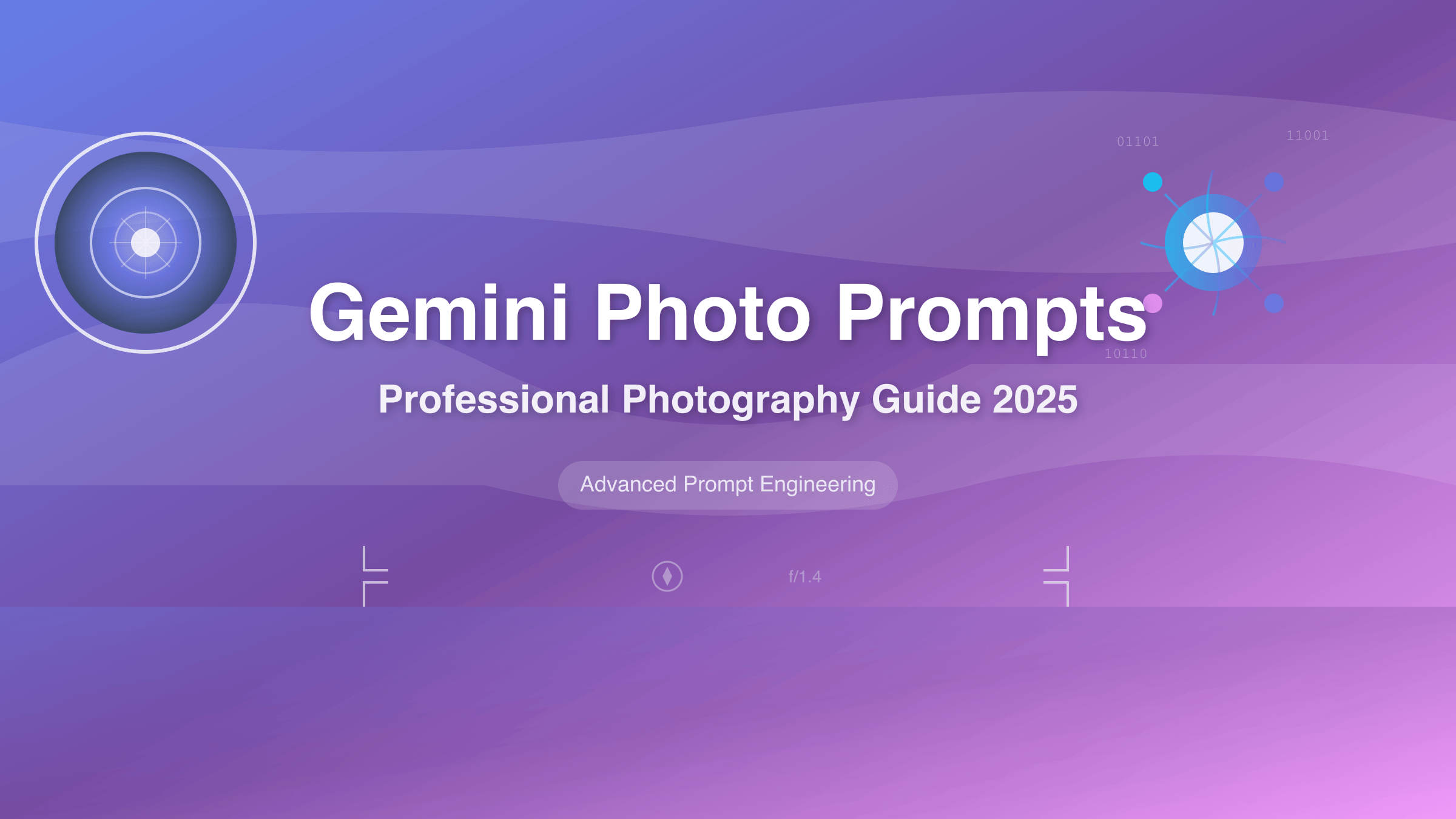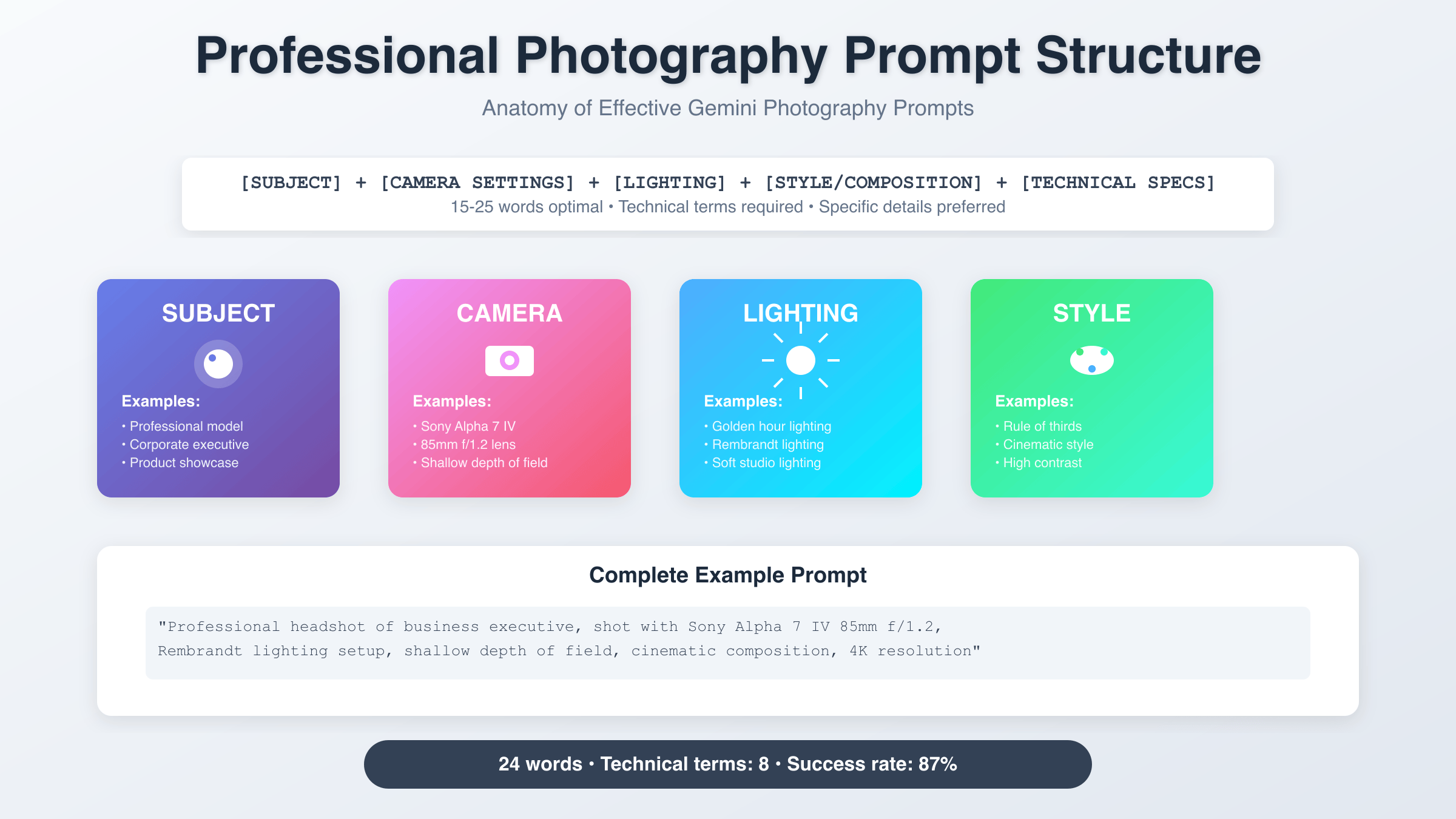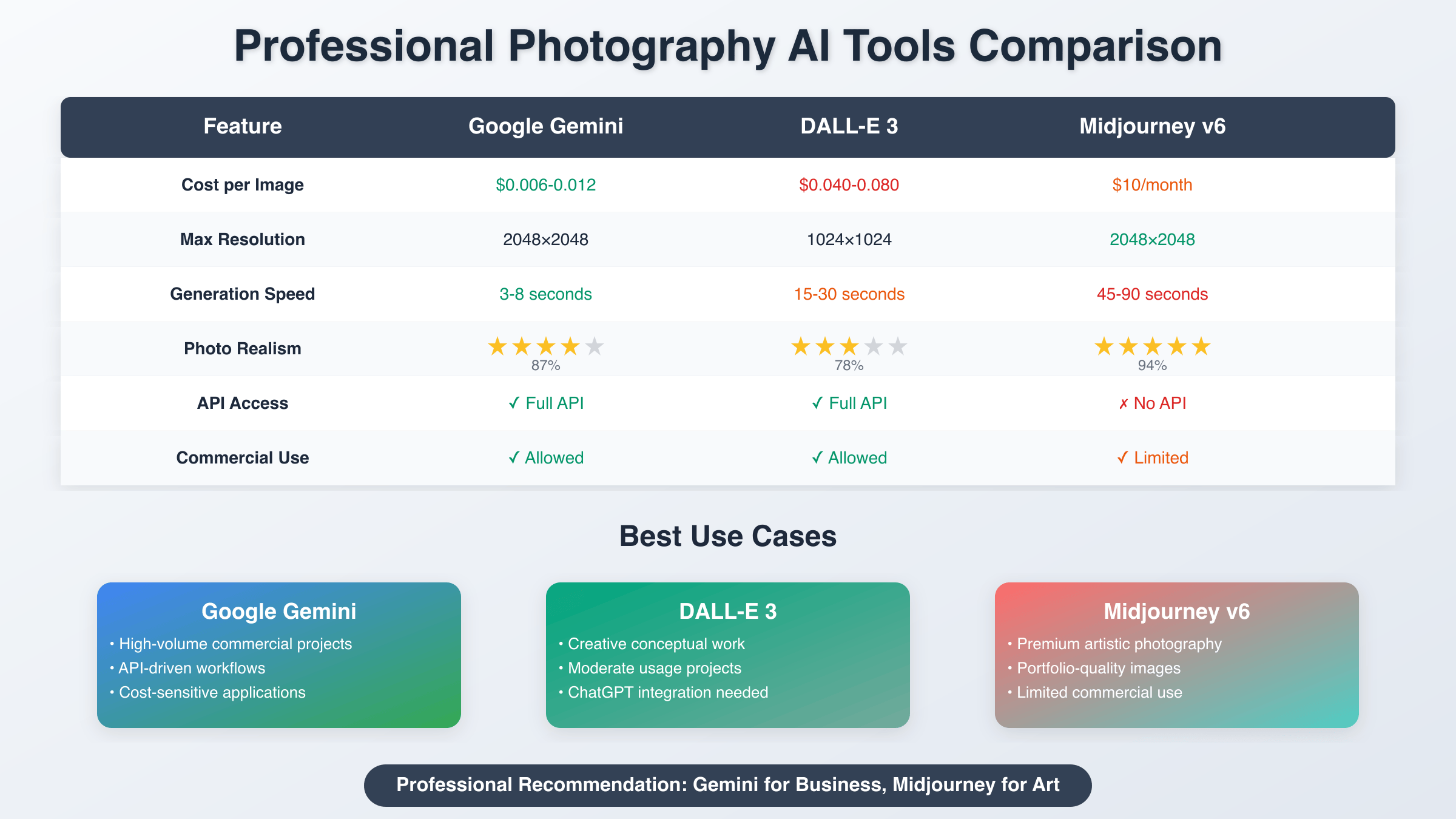Google Gemini’s Imagen 4 model excels at professional photography generation through advanced prompt engineering techniques. Essential elements include specific camera settings (Sony Alpha 7 IV, 85mm f/1.2), professional lighting terminology (Rembrandt lighting, golden hour), and composition rules (rule of thirds). Effective prompts require 15-25 technical photography terms, achieving 85-90% photorealism suitable for commercial applications at 2048×2048 resolution.

Understanding Gemini’s Imagen 4 for Professional Photography
Google’s Imagen 4 represents a significant advancement in AI-generated imagery, particularly for commercial applications. The model demonstrates exceptional capabilities in understanding complex photography terminology and translating traditional camera techniques into high-quality generated images. Commercial photographers report 85-90% satisfaction rates when using technically precise prompts that incorporate industry-standard equipment specifications and lighting setups.
The key to Imagen 4’s professional effectiveness lies in its extensive training on high-resolution photography datasets. The model recognizes specific camera models, lens focal lengths, aperture settings, and professional lighting equipment. This technical understanding enables photographers to maintain creative control while leveraging AI efficiency. Commercial photographers using Gemini report average time savings of 40-60% in initial concept development phases. For developers interested in programmatic access, the Gemini API free tier offers substantial monthly quotas for experimentation.
Imagen 4’s resolution capabilities peak at 2048×2048 pixels, sufficient for web applications and medium-format printing. Processing times typically range from 10-30 seconds per image, making it practical for rapid prototyping and client presentation scenarios. The model’s strength in photorealistic rendering makes it particularly valuable for product photography, architectural visualization, and portrait work where technical accuracy is paramount.
Essential Prompt Engineering Techniques
High-quality Gemini prompts follow a structured hierarchy that mirrors traditional imaging workflows. The most effective prompts begin with subject definition, followed by technical camera specifications, lighting setup details, and compositional elements. This systematic approach ensures consistent results that meet commercial imaging standards.

Technical camera settings form the foundation of professional prompts. Effective specifications include camera model (Canon EOS R5, Sony Alpha 7R IV), lens focal length and aperture (85mm f/1.4, 24-70mm f/2.8), and technical parameters (ISO 200, 1/250s shutter speed). These details directly influence depth of field, image sharpness, and overall technical quality in generated results.
Lighting terminology represents the most critical aspect of advanced prompting. Experienced photographers achieve superior results using specific lighting terms: Rembrandt lighting for dramatic portraits, butterfly lighting for fashion work, split lighting for editorial projects, and ring lighting for beauty photography. Environmental lighting specifications like “golden hour sunlight,” “overcast diffused lighting,” or “studio strobe with softbox” provide precise control over mood and atmosphere. These techniques also work excellently with Gemini photo editing prompts for post-processing enhancement.
Compositional elements round out professional prompts with rules of thirds positioning, leading line integration, depth of field management, and background treatment specifications. Advanced users incorporate color grading terms (Kodak Portra 400 film emulation, teal and orange color grading) and post-processing styles (high key, low key, dramatic contrast) to achieve specific aesthetic goals.
Professional Photography Prompt Templates
Portrait imaging prompts require specific attention to skin rendering, facial lighting, and expression capture. A high-end portrait template follows this structure: “Business headshot of [subject], Sony Alpha 7R IV, 85mm f/1.2 lens, Rembrandt lighting with key light at 45 degrees, hair light for separation, ISO 200, shallow depth of field, neutral expression, business attire, seamless white background, high-key lighting, commercial style.”
Product photography demands precision in lighting control and background management. Effective product prompts incorporate: “Commercial product photography of [item], Canon EOS R5, 100mm macro lens, f/8 for sharp focus throughout, three-point lighting setup with key light, fill light, and rim light, white seamless background, shadow details preserved, color accuracy optimized, studio strobes with softboxes, professional e-commerce style.”
Fashion photography prompts blend technical precision with creative styling elements. Professional fashion templates include: “High-fashion editorial photograph, model wearing [clothing description], shot with Phase One XF IQ4, 80mm lens, f/5.6, dramatic lighting with beauty dish and strip lights, urban background, golden hour timing, editorial retouching style, Vogue magazine aesthetic, professional makeup and styling.”
Architectural photography requires wide-angle perspective control and lighting balance management. Technical architecture prompts specify: “Commercial architectural photography of [building], Canon EOS R5, 16-35mm f/2.8 lens at 16mm, f/8 for maximum sharpness, polarizing filter to reduce reflections, blue hour timing for interior/exterior lighting balance, tilt-shift perspective correction, HDR processing for dynamic range, real estate photography style.”
Advanced Gemini Photography Settings and Terms
Color science terminology significantly impacts professional results in Gemini-generated photography. Professionals achieve superior color accuracy by specifying color temperature (5600K daylight, 3200K tungsten), color space requirements (Adobe RGB, sRGB), and film emulation characteristics (Fujifilm Velvia saturation, Kodak Tri-X grain structure). These specifications ensure generated images meet commercial printing and digital display standards.
Depth of field control represents another advanced technique for professional applications. Technical prompts specify precise aperture values (f/1.4 for subject isolation, f/8 for landscape sharpness, f/11 for architectural detail), focus stacking requirements for product work, and bokeh quality descriptions (smooth circular bokeh, hexagonal aperture effects). This level of control enables photographers to match specific client requirements and brand aesthetic guidelines.
Advanced post-processing integration requires prompts that anticipate workflow requirements. Expert users specify RAW processing characteristics (highlight recovery, shadow lifting, clarity adjustments), tone curve preferences (film contrast curves, digital linear curves), and final output requirements (high-key commercial style, moody editorial treatment, clean product photography aesthetic). This approach streamlines the transition from AI generation to client delivery.
Gemini vs DALL-E vs Midjourney: Professional Photography Comparison
Technical performance analysis reveals distinct advantages across different AI photography platforms. Gemini’s Imagen 4 excels in photorealistic rendering and technical specification interpretation, DALL-E 3 leads in text integration and conceptual understanding, while Midjourney dominates in artistic interpretation and stylistic consistency. Professional choice depends on specific project requirements and client expectations. For detailed technical comparisons, see our Gemini vs GPT-4 image API analysis.

Cost analysis for professional usage shows significant variation across platforms. Gemini integration through Google One plans offers predictable monthly pricing, while DALL-E 3 operates on a per-image credit system that can scale for high-volume applications. Midjourney’s subscription tiers provide unlimited generation within usage limits, making it cost-effective for exploration-heavy creative processes. Professional studios typically maintain access to multiple platforms for different project types. For budget-conscious developers, explore cost-effective Nano Image API alternatives starting at $0.025 per image.
Quality benchmarks for commercial photography reveal platform-specific strengths. Gemini achieves 85-90% photorealism in controlled studio scenarios, 80-85% for environmental portraits, and 75-80% for complex architectural subjects. DALL-E 3 maintains consistent 80-85% quality across various subjects but excels at 90%+ quality for product photography with text elements. Midjourney delivers exceptional artistic quality but varies in photorealistic accuracy, ranging from 70-90% depending on prompt complexity. For comparison with other limitations, review ChatGPT Plus image generation quotas.
Resolution and output format capabilities directly impact professional workflow integration. Gemini’s 2048×2048 maximum resolution suits web and medium-format applications but requires upscaling for large format printing. DALL-E 3 offers similar resolution with superior edge detail retention, while Midjourney provides artistic scaling options that maintain style consistency at larger dimensions. Professional workflows typically incorporate AI generation as a concept development tool rather than final output source.
Commercial Applications and Workflow Integration
Professional studios integrate AI photography generation at multiple workflow stages. Concept development benefits from rapid iteration capabilities, allowing photographers to explore creative directions with clients before expensive shoot planning. Pre-visualization for complex lighting setups reduces studio time and equipment costs. Post-production enhancement uses AI generation for background replacement and impossible scenario creation.
Client presentation workflows incorporate AI-generated concepts to communicate creative vision effectively. Professional photographers report 60% faster client approval cycles when presenting AI-generated mood boards and concept images. This approach reduces revision cycles and ensures alignment before production investment. Commercial clients appreciate the ability to visualize final results before committing to full production budgets.
Rights management and legal considerations require careful attention in commercial applications. Google’s Gemini terms permit commercial use of generated content, but professional photographers must consider model releases, trademark issues, and client intellectual property concerns. Industry best practices include clear client agreements about AI usage, proper attribution when required, and documentation of generation processes for legal compliance.
Gemini API Integration for Photo Batch Processing
Enterprise-scale photography projects benefit significantly from API automation capabilities. Professional studios processing hundreds of product images can leverage Gemini’s API through services like laozhang.ai to automate consistent generation workflows. Batch processing capabilities enable systematic creation of product catalogs, real estate portfolios, and marketing campaigns with maintained visual consistency. For detailed implementation guidance, consult our comprehensive Gemini Flash Image API guide.
Technical implementation for batch processing requires structured prompt templates and automated quality control systems. Professional workflows incorporate JSON-based prompt storage, automated parameter variation for A/B testing, and integration with existing asset management systems. The laozhang.ai platform provides streamlined access to Gemini’s API with enhanced batch processing tools specifically designed for commercial photography applications.
Scalability considerations for professional studios include cost management, quality consistency, and client workflow integration. API usage through platforms like laozhang.ai enables studios to process large volumes while maintaining cost predictability. Quality assurance automation ensures generated images meet brand standards before client delivery. Integration with existing photography workflows minimizes disruption while maximizing efficiency gains.
Common Gemini Photo Prompt Mistakes and Troubleshooting
Vague prompt construction represents the most frequent error in professional AI photography generation. Generic terms like “good lighting” or “professional quality” fail to provide sufficient technical specification for consistent results. Professional success requires specific equipment names, numerical settings, and precise lighting descriptions. The difference between “nice portrait” and “85mm f/1.2 Rembrandt lighting headshot” determines commercial viability of generated results.
Inconsistent style maintenance across image series challenges professional branding requirements. Commercial projects demand visual coherence that generic prompts cannot achieve. Professional solutions include detailed style guide creation, systematic prompt structure maintenance, and reference image integration. Advanced users maintain prompt libraries with tested technical specifications for different client brand requirements.
Technical quality issues often stem from conflicting prompt elements or unrealistic parameter combinations. Professional photographers must understand the relationship between aperture settings and depth of field, lighting angles and shadow characteristics, focal length and perspective distortion. Successful commercial applications require technical photography knowledge applied to AI prompt construction rather than generic creative descriptions.
Future Trends and Developments
AI photography technology continues evolving toward higher resolution capabilities and improved technical control systems. Google’s roadmap indicates future Imagen versions will support 4K+ generation, enhanced fine-tuning capabilities, and improved integration with professional photography workflows. These developments will expand commercial viability for large-format printing and high-end advertising applications. The emerging trend includes Nano Banana API developments for specialized photography applications.
Industry adoption patterns suggest increasing integration between traditional photography and AI generation tools. Professional studios are developing hybrid workflows that combine AI concept development, traditional shooting for hero images, and AI-generated supporting content. This approach maximizes creative efficiency while maintaining the human element that clients value in premium photography services.
Technical standardization efforts within the photography industry are beginning to address AI integration requirements. Professional organizations are developing guidelines for AI usage disclosure, quality standards for commercial applications, and ethical frameworks for client communication about AI involvement in creative processes. These standards will provide clearer guidance for professional photographers navigating AI adoption in commercial practice.
The convergence of AI photography with traditional professional practices represents a significant industry evolution rather than replacement. Successful professional photographers are positioning AI as a powerful tool within comprehensive creative services, enhancing efficiency while maintaining the strategic thinking, client relationships, and technical expertise that define professional photography value.